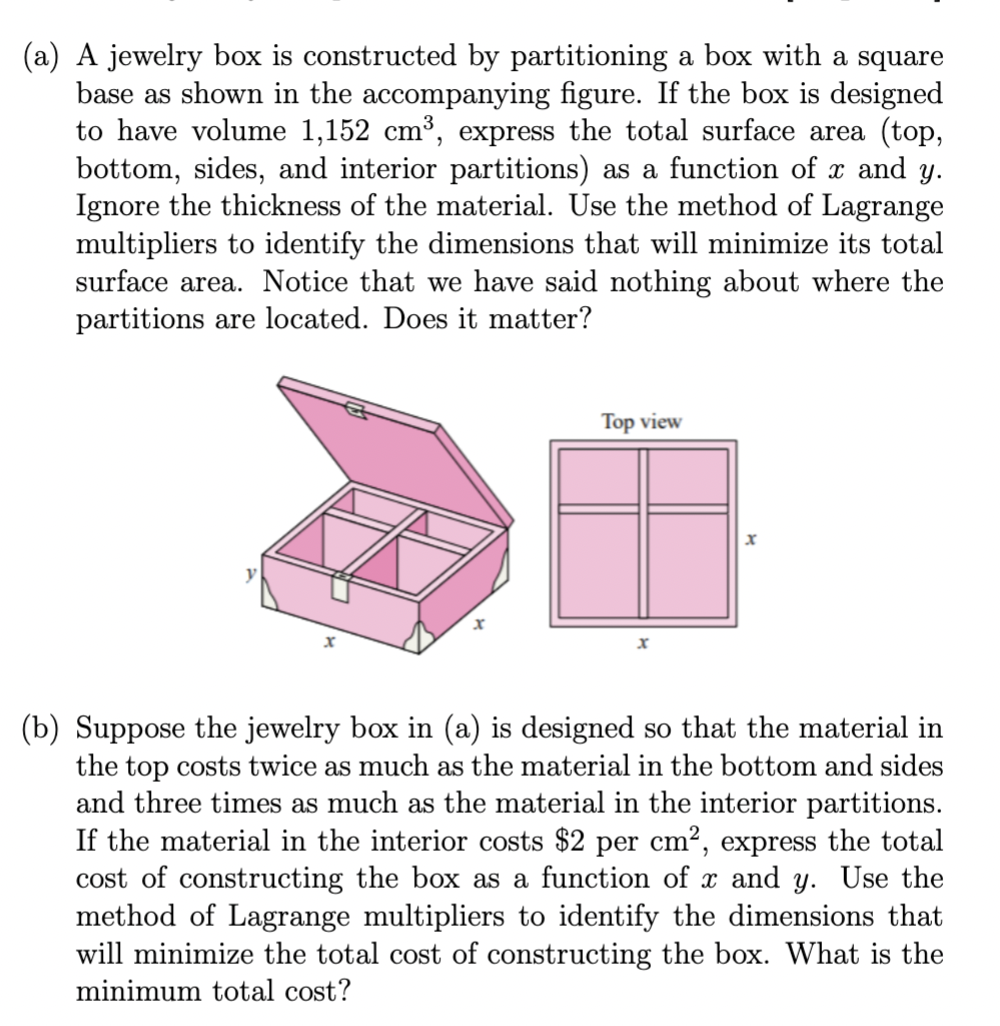A jewelry box is constructed by partitioning a box with a square base as shown in the accompanying figure. If the box is designed to have volume 1,152 cm³, express the total surface area (top, bottom, sides, and interior partitions) as a function of x and y. Ignore the thickness of the material. Use the method of Lagrange multipliers to identify the dimensions that will minimize its total surface area. Notice that we have said nothing about where the partitions are located. Does it matter? Top view Suppose the jewelry box in (a) is designed so that the material in the top costs twice as much as the material in the bottom and sides and three times as much as the material in the interior partitions. If the material in the interior costs $2 per cm², express the total cost of constructing the box as a function of x and y. Use the method of Lagrange multipliers to identify the dimensions that will minimize the total cost of constructing the box. What is the minimum total cost?
A jewelry box is constructed by partitioning a box with a square base as shown in the accompanying figure. If the box is designed to have volume 1,152 cm³, express the total surface area (top, bottom, sides, and interior partitions) as a function of x and y. Ignore the thickness of the material. Use the method of Lagrange multipliers to identify the dimensions that will minimize its total surface area. Notice that we have said nothing about where the partitions are located. Does it matter? Top view Suppose the jewelry box in (a) is designed so that the material in the top costs twice as much as the material in the bottom and sides and three times as much as the material in the interior partitions. If the material in the interior costs $2 per cm², express the total cost of constructing the box as a function of x and y. Use the method of Lagrange multipliers to identify the dimensions that will minimize the total cost of constructing the box. What is the minimum total cost?
Algebra & Trigonometry with Analytic Geometry
13th Edition
ISBN:9781133382119
Author:Swokowski
Publisher:Swokowski
Chapter7: Analytic Trigonometry
Section7.6: The Inverse Trigonometric Functions
Problem 92E
Related questions
Question

Transcribed Image Text:(a) A jewelry box is constructed by partitioning a box with a square
base as shown in the accompanying figure. If the box is designed
to have volume 1,152 cm³, express the total surface area (top,
bottom, sides, and interior partitions) as a function of x and y.
Ignore the thickness of the material. Use the method of Lagrange
multipliers to identify the dimensions that will minimize its total
surface area. Notice that we have said nothing about where the
partitions are located. Does it matter?
Top view
x
(b) Suppose the jewelry box in (a) is designed so that the material in
the top costs twice as much as the material in the bottom and sides
and three times as much as the material in the interior partitions.
If the material in the interior costs $2 per cm², express the total
cost of constructing the box as a function of x and y. Use the
method of Lagrange multipliers to identify the dimensions that
will minimize the total cost of constructing the box. What is the
minimum total cost?
Expert Solution
This question has been solved!
Explore an expertly crafted, step-by-step solution for a thorough understanding of key concepts.
Step by step
Solved in 3 steps with 2 images

Recommended textbooks for you

Algebra & Trigonometry with Analytic Geometry
Algebra
ISBN:
9781133382119
Author:
Swokowski
Publisher:
Cengage



Algebra & Trigonometry with Analytic Geometry
Algebra
ISBN:
9781133382119
Author:
Swokowski
Publisher:
Cengage

